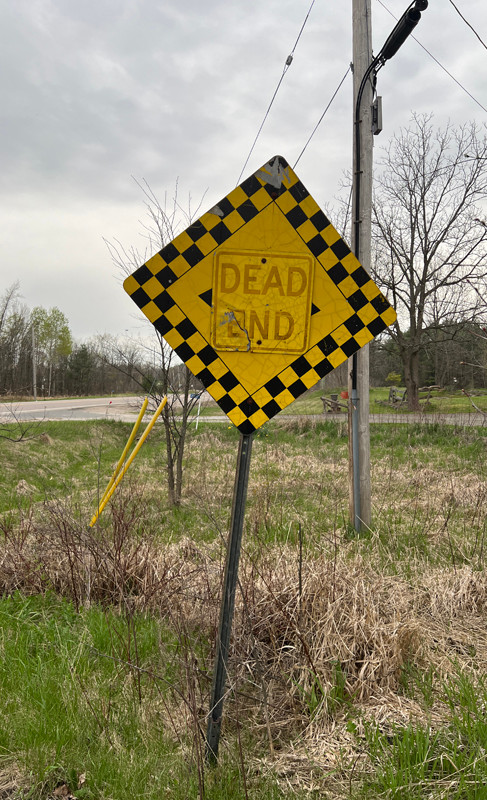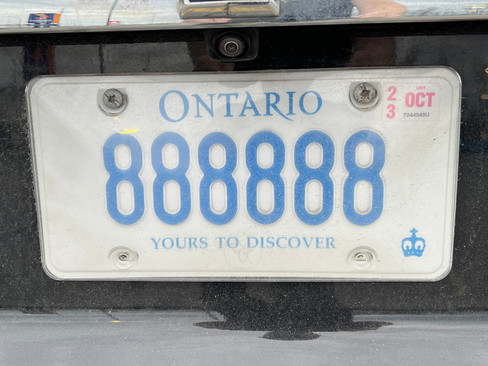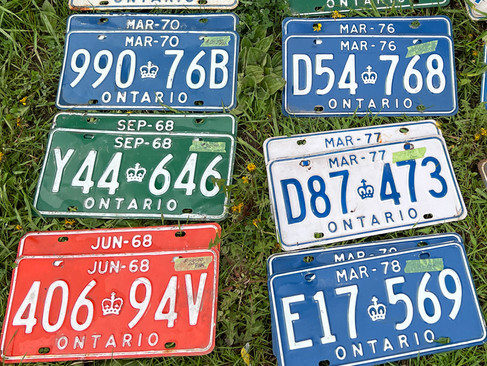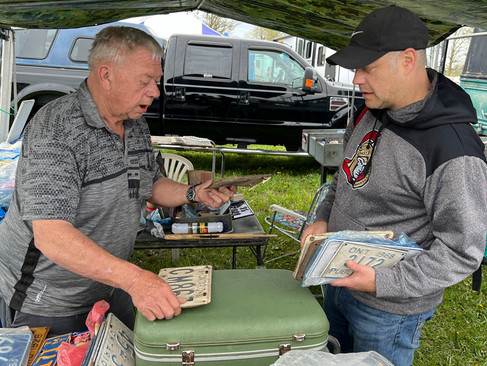I hitched a ride with Eric Vettoretti to the 2024 Stirling Antique Flea Market. He couldn’t make it last year, but was able to this year, as long as he could be home by 5 o’clock to coach one of his kids’ teams. Express trips are a fact of life for us Ottawa collectors.
Left: Me at a 90-degree bend of an abandoned section of Highway 7 near Perth. Right: Old sign where an even older alignment runs into the current highway.
We headed out after work on Friday, taking Highway 7, which is now the route I prefer over the 401. Truck traffic is so heavy on Friday that the 401 is no longer the faster option. Most of it is two lanes each way, so when trucks take 5 minutes to pass each other, it makes for huge bottlenecks. Highway 7 is pretty interesting, because it bypasses many older road alignments that are easy to spot. One of Eric’s spinoff interests is studying old road maps, and he can see where the route changed through the decades. Back in the 1930s, the highway was built largely on farming concessions, with a lot of sharp curves as it zigzagged from one concession line to another. We drove one of the older alignments, east of Perth, where the old pavement is abandoned, but intact. We drove another one that ran roughly parallel to the current highway until it was swallowed up by the current alignment. When you spend as much time on the road as we do, you start to notice these things!

The Senza with old Highway 7 to the left, and current Highway 7 to the right.
We spent the night in Trenton and arrived in Stirling early. It was a perfect day for an outdoor flea market: The ground was dry (easier on the shoes), the sky was overcast (better for pictures), and it was warm enough to dispense with our jackets. Pro tip: The adverts claim a 9 am start time, but the parking lot attendants are taking your money and flagging you along well before that, so show up early.
A couple of random sights in the vicinity.
This was my first time at Stirling since deciding to retire from the YOM business. It was nice to not have the stress of looking through boxes of crappy 1968 plates, scanning for serials that start or end with a certain number or letter... which I may or may not get around to restoring in the next five years. And because of that, I enjoyed my time in the field all the more, which I wasn’t expecting. I was able to focus more on filling gaps in my collection.
For example, we were flipping through a box of plates that had a number of matching pairs. When I encounter a single plate while looking for YOM candidates, I flip past them without a second thought. I’ve kind of “programmed” myself to do that over time. But this time, I found a September ‘68 trailer plate. I didn’t think it was a keeper, but I checked my list, and sure enough, it was the very last gap in my quarterly trailer run. I had probably missed several such plates over the years, for being so fixated on scanning the numbers in the boxes.
Without the YOM aspect, I found myself more interested in random oddities on the field. I came across a small stack of black-and-white truck plates. One of them had a huge sticker stack going from the early 1980s all the way up to 2021. The price was right, so I took the lot. We later visited the Solmes bus; it’s an obligatory stop if you’re at Stirling. It’s often hit-and-miss with YOM items, but occasionally, he brings out some goodies from the garage. One such batch of goodies was a box of March ‘71 quarterly truck plates (yawn), but these had all been used by the buses of the Hamilton Street Railway. I’ve come across other HSR batches over the years. Ontario didn’t issue bus plates formally until 1973, but there are lots of archival bus pictures before then that typically show buses in the quarterly era using March quarterlies in the low B series (meaning four numbers followed by the letter B). So while I’m content to call my bus run complete back to the beginning in 1973, I still try to collect series that I know were used on buses.
Mr. Solmes noticed my interest in the box of quasi-bus plates, and offered the box to me for a reasonable lump sum. I decided to take it because there were quite a few with repeating numbers, including 44-44B, which I’d add to my collection.
I had no choice but to carry the box of 100 plates back to the car, and my arms ached for a while afterward. We continued around the field and saw a couple of YOM–plated campers (with passenger plates though) and a few interesting signs. I love signs, but I just don’t have the room to display them. If I buy another, I’ll have to sell one off to make room. Such is life living in a tiny house.
Left: Eric checks his lists before buying plates. Right: John Hayes with one plate, and me with 101 plates.
We ran into a few people we knew. Paul Frater was trying Stirling out for the first time with his father, and he later bought an illuminated Toronto street sign (Yonge) that was marked down from last year. We also bumped into Scott Craig, whose son came along for the trip. John Hayes stopped by the Solmes bus while we were there. He picked up a mid-eighties moped plate in nice shape. We did pass by Terry Ellsworth, but he was in the middle of an animated conversation with a vendor selling bottles. I didn’t want to interrupt or get in the way of a potential deal, so we left Terry to it.
Stirling is smaller than Barrie, but every single outdoor vendor sells the kind of junque that we collectors are looking for. There are a few vendors in the arena who sell mint Hot Wheels, hockey cards, clothes, or cured meats. But if you take the junque vendors in Barrie and concentrated them all in one spot, you’d have an event the size of Stirling. So in my mind, Stirling has just as much to find as Barrie, but it’s closer to home and makes for more efficient hunting in the field. I get so tired of walking past Barrie vendors selling throws, bongs, or DVDs– or walking past empty plots. In Stirling, everyone is on-topic and there are no empty spots.

We took a quick tour through the car show lot, but found only one YOM-plated car. Given the expense, the cumbersome registration process, and the lack of promotion, it’s no wonder YOMs are hard to find on cars. Just one reason of many that I’ve had enough of YOM.

It was noon, and we were finished in Stirling. We had time to take the scenic route home, so we drove through Chisholm’s Mills to see the namesake water-powered lumber mill on the bank of the Moira River. To get back to the highway, we had to use a couple of century-old concrete bridges to cross the river. We also took a detour north of Kaladar to visit a guy who had sold Eric some plates a few years ago. He has a cool restoration workshop, and he told Eric to drop by anytime the door was open. It was open, so we stopped to say hello. He mentioned that his garage was originally built in 1914 as the town drill hall. The building has since been divided into a “shop” half, with the other side used as living space. There were some plates hanging both inside and out. They were for sale if we wanted them, but we were content with our haul for the day and declined.
We ended our trip with another bygone highway adventure. This time, we took the former secondary highway 506 to the village of Plevna. This part of Ontario is pretty remote, and the county never bothered to remove or change the provincial highway signs when the road was downloaded. What’s more interesting is that former Highway 506 ends in the same spot that is approached by another former Highway— this being Highway 509. 509 approaches from the east, whereas 506 approaches from the west. They just “kiss” at a random spot. Why the entire road span wasn’t assigned the same number, we don’t know. Ontario is weird for having oddities like this, and we’re weird for visiting them.












































Comments